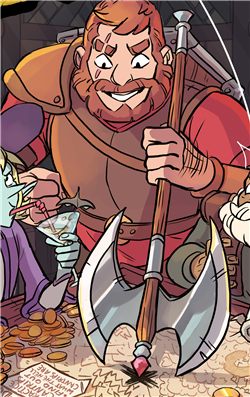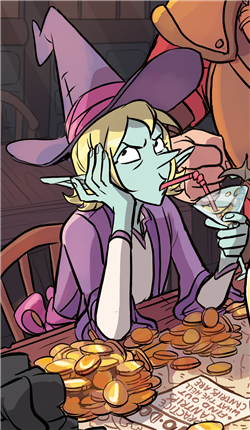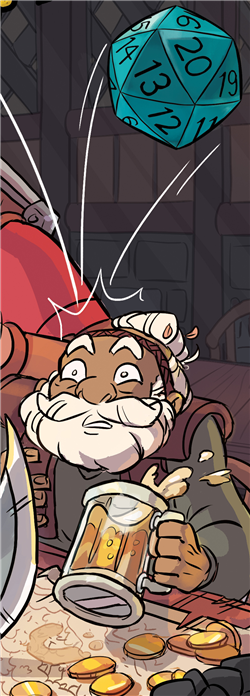The Adventure Zone Releases its First-Ever Adventure!
What if the game is real life, and everything else is just a game? Think about it... the Adventure Zone!
—Griffin McElroy, The Adventure Zone, Episode 9: “Moonlighting, Chapter Three”
Did anyone see this coming? Griffin McElroy, co-creator and Dungeon Master of The Adventure Zone has created a one-shot-length D&D adventure based on his family’s wildly popular podcast. This adventure is paired with the release of The Adventure Zone: Here There Be Gerblins, the first volume of the podcast’s graphic novel adaptation—but it has also been released for free in the latest issue of Dragon+, the official digital D&D magazine.
You can download a PDF of The Return to the Test of Initiation, along with a preview of the graphic novel and an interview with co-author Griffin McElroy and artist Carey Pietsch in this issue of Dragon+.
The Adventure Zone official animated trailer. Content advisory: explicit language.
Reading this Adventure
 Beware: Everything below this point contains SPOILERS for the adventure The Return to the Test of Initiation and up to Episode 9 of The Adventure Zone. Read no further unless you’re planning on DMing this adventure!
Beware: Everything below this point contains SPOILERS for the adventure The Return to the Test of Initiation and up to Episode 9 of The Adventure Zone. Read no further unless you’re planning on DMing this adventure!
The Return to the Test of Initiation is an adventure for a party up to six pregenerated characters from the Adventure Zone podcast. These characters include the show’s three main heroes, Taako the elf wizard, Merle Highchurch the dwarf cleric, and Magnus Burnsides the human fighter (who recently appeared in a game of Dice, Camera, Action on the Stream of Many Eyes!). The other three characters are fan-favorite NPCs from the show, Killian the orc fighter, her girlfriend Carey Fangbattle the dragonborn rogue, and Johann the half-elf bard.
The adventure itself begins with a note from Griffin McElroy quickly describing the adventure, welcoming new players to D&D, and explaining how they can start playing D&D free using the Basic Rules. It’s instantly clear from this introduction that Return to the Test of Initiation is aimed primarily at a specific group of people: those who have listened to (at least some of) The Adventure Zone or who have read the graphic novel, but have also never played D&D before. This is an excellent gesture, and it’s one I hope other popular D&D shows like Critical Role and Dice, Camera, Action will replicate.
If you’re used to the impersonal and omniscient style of modern D&D adventures, Griffin’s familiar and irreverent writing style may be a slight shock to the system. This adventure treats its fantasy subject matter with great levity, just like the podcast that inspired it. Griffin’s own editorializing remarks appear throughout the text, often poking fun at himself and his family’s actions in their own game. In fact, there are lots of little “imperfections” in fifth edition style throughout the text that may rankle D&D purists. Read-aloud text isn’t boxed, but instead put in quotation marks. Magic items are listed in plain text, ignoring rarity. Skill checks are used without referring to their associated ability score, just like one might say them aloud (who really says “make a Wisdom (Perception) check” instead of just “make a Perception check,” anyway?).
Beyond this, the adventure’s linear structure and clear goals make it a fine starting place for new players and Dungeon Masters alike—with the caveat that they are fans of The Adventure Zone in the first place. The adventure is called The Return to the Test of Initiation, after all. If you plan to run this adventure, you ought to at least be familiar with the first 10 episodes of TAZ, or have read the first volume of the graphic novel so that you are aware of the Bureau of Balance, its mission, and its members. It’s not necessary that your players be familiar with TAZ, but it will enhance their enjoyment.
Playing this Adventure
 Playing as Adventure Zone characters in the Adventure Zone universe is somewhat reminiscent of Dragonlance, insofar as you are playing as a set of preexisting characters that have known personalities and ways of behavior in a D&D setting—and even if the adventure you are playing them in isn’t exactly the same as the one they undertook in their original story, it’s immediately familiar. Players familiar with the source material may have some reservations as playing as a character they know intimately… or they may feel disappointed if a friend unfamiliar with the podcast plays their character differently than the McElroys did.
Playing as Adventure Zone characters in the Adventure Zone universe is somewhat reminiscent of Dragonlance, insofar as you are playing as a set of preexisting characters that have known personalities and ways of behavior in a D&D setting—and even if the adventure you are playing them in isn’t exactly the same as the one they undertook in their original story, it’s immediately familiar. Players familiar with the source material may have some reservations as playing as a character they know intimately… or they may feel disappointed if a friend unfamiliar with the podcast plays their character differently than the McElroys did.
If you are their Dungeon Master, help them overcome this need for perfection. While you may be playing characters created by other people, imagine that you are just a different writer on a mainstream comic book. Wonder Woman behaves differently from comic to comic, depending on who’s writing (and illustrating) her, and James Bond’s character differs from film to film, depending on who’s playing him.
This same advice applies to you when you’re playing the familiar NPCs: Director Lucretia and Leon the Artificer.
One thing that you can replicate perfectly, however, is the music. Using Griffin’s original music for The Adventure Zone during this game will help you capture that nostalgic, quietly epic tone that suffuses the podcast’s best moments. All of the TAZ albums can be found on Griffin’s Bandcamp page. And, of course, there’s the TAZ theme song: Deja Vu by Mort Garson.
Most of all, though, there’s one thing you can do to capture the elusive TAZ feeling while playing this adventure. It’s actually very simple: stay relaxed. Let your players goof off. Let them take strange diversions and wreak a little havoc. Don’t sweat the minutiae of the D&D rules. Let them be totally out of character and annoy your NPCs to no end. And then when their antics have run their course, speedily usher them to the next scene, and repeat the process.
Improving this Adventure
 Okay, I know I just said that part of the elusive TAZ charm is not caring about the little details of D&D’s rules, but there are some issues with the rules and flow of this adventure that need to be made clear. The first official TAZ adventure is a fun and flavorful maiden voyage, but there are places where its casual tone and vague mechanics could cause problems for rookie Dungeon Masters. Most of these glitches are common enough to be smoothed over on the fly by an experienced DM, but this adventure is aimed primarily at fans of The Adventure Zone who have never played D&D before, or who have only played once or twice. Here are some suggestions on how to mark up your copy of this adventure before you run it.
Okay, I know I just said that part of the elusive TAZ charm is not caring about the little details of D&D’s rules, but there are some issues with the rules and flow of this adventure that need to be made clear. The first official TAZ adventure is a fun and flavorful maiden voyage, but there are places where its casual tone and vague mechanics could cause problems for rookie Dungeon Masters. Most of these glitches are common enough to be smoothed over on the fly by an experienced DM, but this adventure is aimed primarily at fans of The Adventure Zone who have never played D&D before, or who have only played once or twice. Here are some suggestions on how to mark up your copy of this adventure before you run it.
Read-Aloud Text
This adventure’s most visible hiccup is how its read-aloud text is displayed on the page. “Read-aloud text” here refers to text that is designed for the DM to read or paraphrase to the players to set the scene or to communicate specific NPC dialogue. In most D&D adventures, this text is visually demarcated from the body text by a light-gray box—but this adventure simply uses quotation marks, causing the read-aloud text to blend into the body text unless you’re paying very close attention. This might cause you to accidentally start reading vital and secret information aloud, or your eye might skip over the read-aloud text completely.
Solution: Print out this adventure and either highlight the read-aloud text (like an actor might highlight their lines in a play script), or use a permanent marker to draw a box around the read-aloud text.
Ability Checks
This adventure often refers to ability checks as skill checks, eschewing the typical fifth edition style of writing a “Strength (Athletics) check” as simply an “Athletics check.” If you play official D&D adventures after this one, don’t be surprised when you see ability checks written in the former style. They’re exactly the same, as described in chapter 7 of the Player’s Handbook.
There are, however, a few checks that look like they were taken straight from the author’s notes and never updated to fit the D&D rules. Notably, there’s a point on page 20 of the PDF that calls for “a moderate Thieves Tools check.” While the Player’s Handbook has guidelines on how to assign ability checks a DC based on the difficulty of the task, no D&D adventures ever refer to checks in this way.
Solution: Read the phrase “a moderate Thieves Tools check” as “a DC 15 Dexterity check using thieves’ tools.” This means that if a character is proficient with thieves’ tools, such as most rogues, they can add their proficiency bonus to this Dexterity check. In this adventure, the pregenerated character Carey Fangbattle is proficient with thieves’ tools, so she has a +5 bonus to this check!
Combat Encounters
Since this adventure doesn’t use bold text to indicate monsters in its body text, it can be hard to assess how many monsters the player characters will be fighting at a glance. It’s worth creating an encounter cheat sheet for the two combat encounters in this adventure.
In “The Test of Initiation, Part Two,” the player characters must fight five automata. Three soldier automatons, one spider automaton, and one red ogre automaton. The latter two are interesting, as the red ogre cannot fight until it is repaired by the spider.
There is a lot of information to keep straight in “The Mastermind,” the climactic encounter of the adventure. And with three tactically complex stat blocks spread out across two pages, running this encounter can be a challenging mental juggling act. Note that the manufacturing arms act on Carlyle’s initiative, and he has to use his action to command them to act, whereas the dragon automaton acts independently. Note that Carlyle’s “Tinfoil Helmet” trait gives him immunity to the charmed condition and to psychic damage, neither of which are directly noted in his damage or condition immunities. His dwarvish heritage should also give him resistance to poison damage (not immunity) and immunity to the poisoned condition.
There are also some vague mechanics in this fight: namely, how to attack Carlyle while he is protected by his Safety Cage. The Safety Cage is a stationary box of iron with glass windows and a locked door. In order to open the door, its lock must first be picked using thieves’ tools, and then the fused-shut door must be pried open with brute strength. No DCs are specified for this check, instead it says: “If investigated, the players will realize the fuse job was rushed and can easily be overcome with strength or melted down with fire.”
Solution: If you don’t want to just make up numbers on the fly for opening the door, here are some you can use in your game. These are the numbers I would use ad hoc if I were to run this adventure. Unlocking the door requires a character to make a successful DC 15 Dexterity check with thieves’ tools (as mentioned in “Ability Checks,” above), and then a successful DC 12 Strength check to pry open. The door also instantly melts to slag if it takes at least 8 points of fire damage.
The safety box also has a glass window protected by metal latticework. The glass window has 5 hit points and is immune to poison and psychic damage. It shatters when reduced to 0 hit points. Carlyle can be targeted by ranged attacks when the window is broken, but the metal bars must be broken in order to get inside the Safety Box. The metal lattice has 20 hit points and an AC of 16. It is immune to poison and psychic damage, but is vulnerable to fire damage. The bars could also be bent open, Superman-style, by a successful DC 20 Strength check.
Character Sheets
These pregenerated characters need another editing pass. There are numerical mistakes all over them, from saving throws to Armor Class to Hit Dice, and everything in between. If you care about the underlying math of D&D even a little bit, it would do you a world of good to take a permanent marker to each and every one of these sheets. There are too many little mistakes to list here, but pay special attention to the math of the characters' ability scores and how they relate to skills and saving throws, and their equipment and how they relate to attack bonus and Armor Class (Magnus's railsplitter axe is particularly messy).
Should you Play The Return to the Test of Initiation?
If this adventure will be your first exposure to The Adventure Zone, I highly recommend you listen to the podcast first. You’ll enjoy both this adventure and the podcast more if you listen to it before playing.
If you love The Adventure Zone and are new to actually playing D&D, the answer is a resounding yes. You will love this adventure. Its mechanical errors won’t get in the way of your enjoyment of the adventure much, especially if you approach this game with the character-first, rules-second philosophy that the McElroys had throughout their entire show. Even if you do have a problem with the occasional rules glitches in this adventure, you can use the suggestions in this article to help make your game run more smoothly.
The Adventure Zone is a comedic, story-driven D&D podcast created by Griffin McElroy, Justin McElroy, Travis McElroy, and Clint McElroy. You can listen to the first episode on MaximumFun.org.
All artwork is from the cover of The Adventure Zone: Here There Be Gerblins, illustrated by Carey Pietsch and published by Macmillan Publishers.
 James Haeck is the lead writer for D&D Beyond, the co-author of Waterdeep: Dragon Heist and the Critical Role Tal'Dorei Campaign Setting, and is also a freelance writer for Wizards of the Coast, the D&D Adventurers League, and Kobold Press. He lives in Seattle, Washington with his partner Hannah and their little memory-draining voidfishes, Mei and Marzipan. You can usually find him wasting time on Twitter at @jamesjhaeck.
James Haeck is the lead writer for D&D Beyond, the co-author of Waterdeep: Dragon Heist and the Critical Role Tal'Dorei Campaign Setting, and is also a freelance writer for Wizards of the Coast, the D&D Adventurers League, and Kobold Press. He lives in Seattle, Washington with his partner Hannah and their little memory-draining voidfishes, Mei and Marzipan. You can usually find him wasting time on Twitter at @jamesjhaeck.








-
View User Profile
-
Send Message
Posted Jun 20, 2018Happy for those adventuring boys!
-
View User Profile
-
Send Message
Posted Jun 20, 2018I love that Tres Horny Boys are becoming famous in the D&D world. Maybe Wizards of the Coast will make a TAZ setting. That would be dope.
-
View User Profile
-
Send Message
Posted Jun 20, 2018Good discussion of the podcast, the adventure it inspired, and how to approach running the dang thing.
-
View User Profile
-
Send Message
Posted Jun 20, 2018gonna try gming this
-
View User Profile
-
Send Message
Posted Jun 21, 2018has any fan done this for the critical roll adventures? I would have thought someone would have.
-
View User Profile
-
Send Message
Posted Jun 21, 2018Using the Tal'Dorei Campaign Setting to create and run your own adventures at home in the world of Exandria would be just fine, but actually selling them would be very illegal.
-
View User Profile
-
Send Message
Posted Jun 21, 2018OH not selling them. just fan posts. People post fan fiction ... how is fan fiction adventure any different?
-
View User Profile
-
Send Message
Posted Jun 21, 2018AAAAAW YESSS!
-
View User Profile
-
Send Message
Posted Jun 21, 2018"you haven't seen his ass" LOL
-
View User Profile
-
Send Message
Posted Jun 21, 2018It's not as long as you don't sell it. At that point it becomes illegal.
-
View User Profile
-
Send Message
Posted Jun 21, 2018I was surprised fans havent made adventures based on the games and posted their maps and encounters... never said anything about selling.
I can see where people might get confused.
Adventure Time people are publishing their content.
I said "Fans" ... but didnt specifically say NOT publishing/Selling
Sorry for the confusion
-
View User Profile
-
Send Message
Posted Jun 21, 2018I think it's when you said "has any fan done this for critical role" that threw people off. As in, has any fan made a module to sell or made a graphic novel to sell.